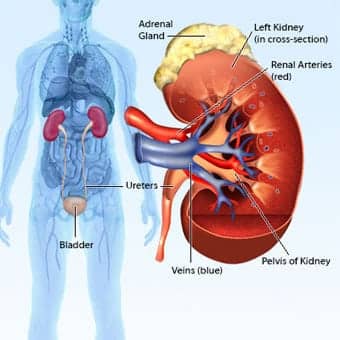This article will focus on kidney cancers and the possibility that kidney cancers may be due an inherited risk. It is estimated that ~3-5% of kidney cancers are hereditary.
 Photo Credit: WebMD
Photo Credit: WebMDUsually, a person is born with two kidneys. They are located in the rear of the abdominal cavity. The job of the kidneys is to filter blood, get rid of waste products, and make urine. The kidneys also control the body’s fluid balance and regulate the balance of electrolytes (ex: sodium, calcium, and magnesium).
Sometimes, cells within the kidney grow out of control and become cancerous, forming a tumor. Kidney cancers can be divided into several subtypes: clear cell (~75%), papillary (~10-15%), chromophobe (~5%) and oncocytomas (~5%).
When kidney cancer or benign kidney tumors occur, it is important to document them in your family history and to report them to your physician. This information can help your genetics team determine if genetic testing may be right for you/your family and aids in interpreting your genetic test results correctly.
The following red flags increase the likelihood of a hereditary risk for kidney cancer.
When any of these red flags are present in your personal or family history, consider a genetic consultation to learn more.
 Photo Credit: Clipart Kids
Photo Credit: Clipart Kids
1. Kidney cancer that develops ≤45 years of age.
2. More than one kidney cancer/tumor in the same person.
3. Strong family history of kidney cancer (≥2 relatives on same side of family).
4. Kidney cancer with either:
a) Personal or family history of ≥1 other type of tumor that have been linked with a hereditary risk for kidney cancer (ex: specific types of tumors of the endocrine system, brain, pancreas, eyes or uterus. See Part 2 of this series for more detail).
b) lung cysts or collapsed lung.
5. Specific skin findings that have been linked with a hereditary risk for kidney cancer (Leiomyomas or Fibrofolliculomas).
6. Personal or family history of any of the hereditary cancer syndromes discuss in Part 2 of this post.

